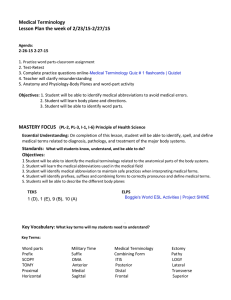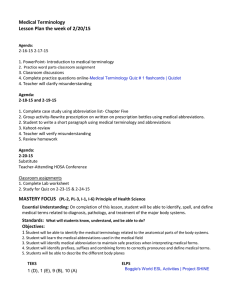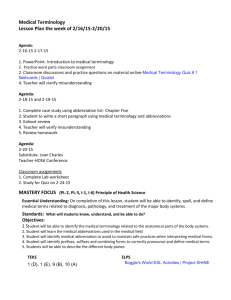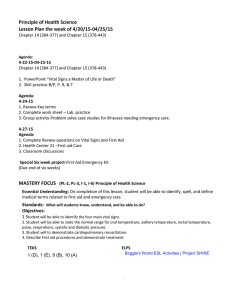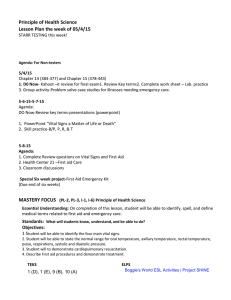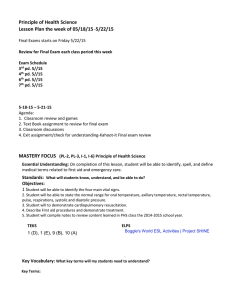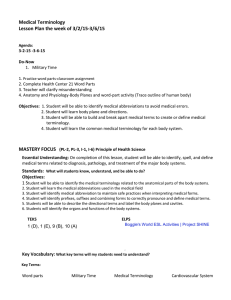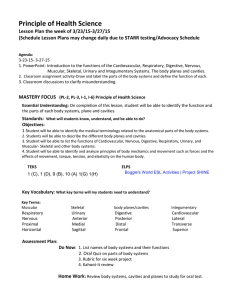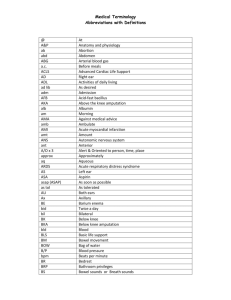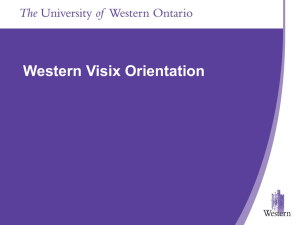Medical Terminology Lesson Plan the week of 2/18/15
advertisement
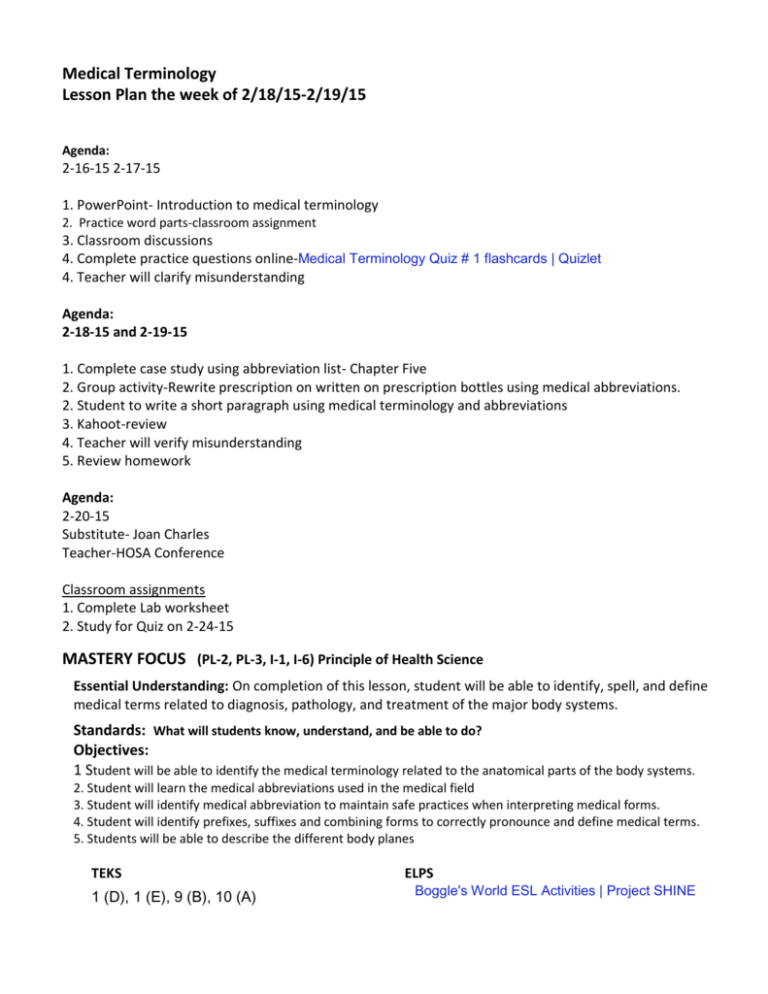
Medical Terminology Lesson Plan the week of 2/18/15-2/19/15 Agenda: 2-16-15 2-17-15 1. PowerPoint- Introduction to medical terminology 2. Practice word parts-classroom assignment 3. Classroom discussions 4. Complete practice questions online-Medical Terminology Quiz # 1 flashcards | Quizlet 4. Teacher will clarify misunderstanding Agenda: 2-18-15 and 2-19-15 1. Complete case study using abbreviation list- Chapter Five 2. Group activity-Rewrite prescription on written on prescription bottles using medical abbreviations. 2. Student to write a short paragraph using medical terminology and abbreviations 3. Kahoot-review 4. Teacher will verify misunderstanding 5. Review homework Agenda: 2-20-15 Substitute- Joan Charles Teacher-HOSA Conference Classroom assignments 1. Complete Lab worksheet 2. Study for Quiz on 2-24-15 MASTERY FOCUS (PL-2, PL-3, I-1, I-6) Principle of Health Science Essential Understanding: On completion of this lesson, student will be able to identify, spell, and define medical terms related to diagnosis, pathology, and treatment of the major body systems. Standards: What will students know, understand, and be able to do? Objectives: 1 Student will be able to identify the medical terminology related to the anatomical parts of the body systems. 2. Student will learn the medical abbreviations used in the medical field 3. Student will identify medical abbreviation to maintain safe practices when interpreting medical forms. 4. Student will identify prefixes, suffixes and combining forms to correctly pronounce and define medical terms. 5. Students will be able to describe the different body planes TEKS 1 (D), 1 (E), 9 (B), 10 (A) ELPS Boggle's World ESL Activities | Project SHINE ( Key Vocabulary: What key terms will my students need to understand? Key Terms: Word parts Prefix SCOPY TOMY Proximal Horizontal Military Time Suffix OMA Anterior Medial Sagittal Medical Terminology Combining Form ITIS Posterior Distal Frontal Ectomy Pathy LOGY Lateral Transverse Superior Assessment Plan: Discuss knowledge of key terms. Do Now: 1. Student will build medical terms 2. Quiz on word parts 3. Spelling quiz Home Work: Breaking down word by identifying prefix, suffix, and combining form LESSON CYCLE I. Students Will learn the key terms, military time, medical abbreviation, and word parts. Why It Is Important? (The students need to know the meaning of the key terms, medical abbreviations, and word parts to correctly interpret medical orders, medical documentation, medical history taking, prescriptions, and other medical forms related to the body systems. Health care workers are expected to recognize most common abbreviations and the correct pronunciation of medical terms. Health Science students must learn the fundamentals of what is needed to prevent Medication errors and provide the highest optimal care to patients by correctly Interpreting doctor orders and medical data. II. Introduction to New Material – a. Students will view and discuss a PowerPoint on introduction to medical terminology. b. Review content in text book and handouts. c. Review content related to lesson per website and links to medical terminology III. Guided Practice a. Teacher will clarify and check for understanding by asking open-ended questions. b. Teacher will pace the classroom to clarify misunderstanding. c. Teacher will introduce content to be learned and review key terms. d. Teacher will demonstrate skill practices. e. Teacher will review agenda and objectives daily f. Teacher will review resources and equipment needed to problem solve student centered lessons. g. Teacher will provide a study guide to prepare for 6 weeks test. IV. Independent Practice a. Student to define and write key terms. b. Student to take notes from PowerPoint. c. Student to complete homework d. Student to complete worksheets in class e. Student to identify parts of the body systems using the proper medical terms f. Groups and independent study to learn medical terms. g. Use overhead projector to present content learn V. The Closing – Classroom discussions to check for understanding. Ask students did we meet and learn the objectives for the day. Play kahoot or other games to check for mastery. Clarify misunderstanding. How will I engage my students in learning? How will I lead my students to mastery? CHECKS FOR UNDERSTANDING (I-2) 1 Engage and Connect (30-min): Do Now: 15 minutes Hands on group activity Independent practice Online group studies. Group activity –Problem solve questions related to the body systems. 2 Introduce New Learning (15-20 min): PowerPoint- Introduction to medical terminology Health Century 21 Movie “Miracle Hands” Demonstrate skill practice Explain why correct pronunciation of medical terms prevent medical errors. Introduce Prefixes, suffixes, and combining forms to make word parts. Provide case study for independent student centered learning. 3 Lead Guided and Independent Practice (25 min): Guided Practice (10 min): Demonstrate How to use combing forms and word parts. Review actual malpractice cases due to misinterpreting MD orders or medical documentation. Health Century 21-lesson plans, online practice and work sheets. Independent Practice (25-30 min): Review Do Now Clarify misunderstanding Allow students to demonstrate what was learned Student provide feedback by demonstrating skills. Student are able to voice why lesson is important during guided questions Student provide feedback on the overhead board practicing breaking down medical terms Clarify misunderstanding. By asking questions and reteach material as needed. Problem solve case studies to define medical terms and abbreviations. Complete lab worksheet Complete homework 4 Close the Lesson and Assess Mastery (10 min): Check understanding by open ended questions involving all students. Play Kohoot. Exit ticket Quizzes Peer Review Feedback Accountable talk. Test (six week) DIFFERENTIATION (I-3) How will I scaffold and/or accelerate learning? For whom? How will I group my students? SCAFFOLD: A Series of online studies and quizzes ACCELERATE: Have students read medical terms out loud and use prior knowledge learn to problem solve. Group activity- Student will present to peers word parts using the overhead projector. Draw and trace a peers’ body to identify the parts of the body & the body planes using medical terminology. GROUP: Group according to academic level (high performing students grouped with lower performing students. (4-5 students per group). ESL student grouped with a Spanish speaking student. LOGISTICS (I-6, I-10) What materials, resources, and technology will I need to prepare and arrange? Text Book Health Century 21 Student workbook-Medical Terminology by Ann Ehrlich & Carol Schroeder Instructor’s Manual Introduction to Medical Terminology by Ann Ehrlich & Carol Schroeder Tracing paper and markers scissors index cards Lab-top (technology based lesson) Diversified Health Occupational PowerPoint Case studies Medical Terminology Quiz # 1 flashcards | Quizlet
